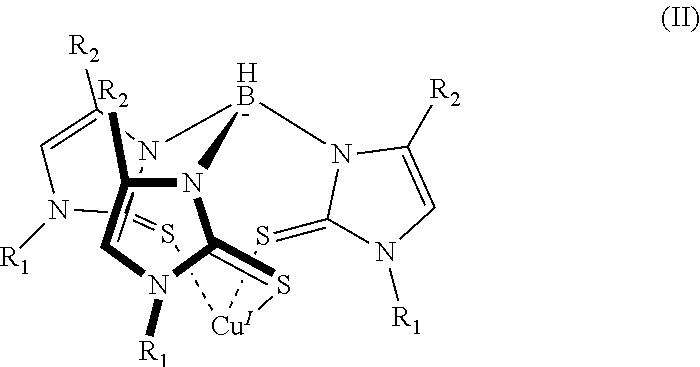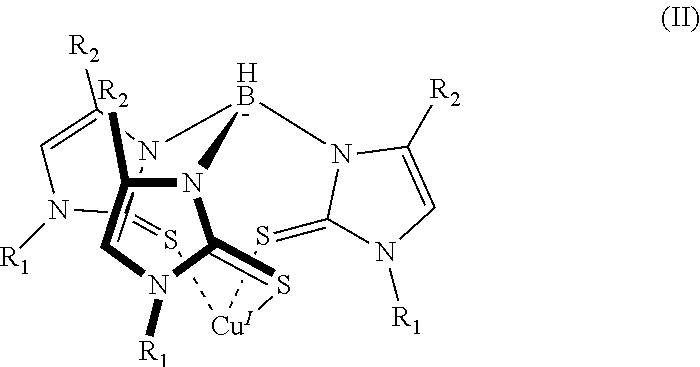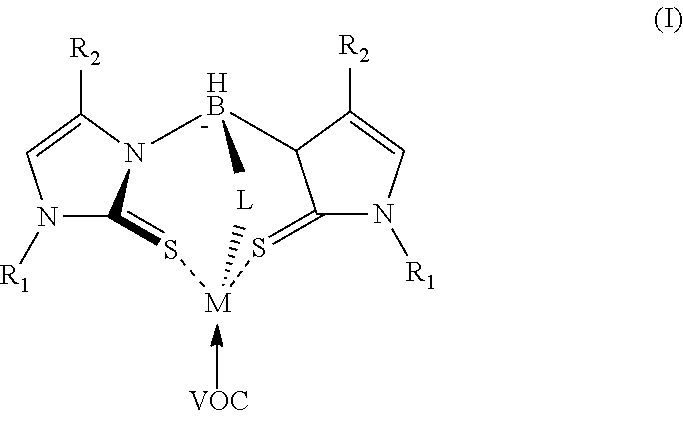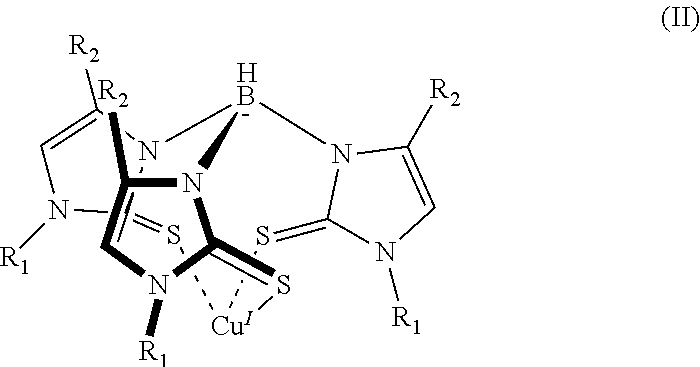Sensor For Detecting Gas Analyte
Wei; Alexander ; et al.
U.S. patent application number 16/811687 was filed with the patent office on 2020-09-17 for sensor for detecting gas analyte. The applicant listed for this patent is CARRIER CORPORATION. Invention is credited to Winston Yen-Yu Chen, Lia Antoaneta Stanciu, Benjamin M. Washer, Alexander Wei, Aiganym Yermembetova.
| Application Number | 20200292481 16/811687 |
| Document ID | / |
| Family ID | 1000004748736 |
| Filed Date | 2020-09-17 |






| United States Patent Application | 20200292481 |
| Kind Code | A1 |
| Wei; Alexander ; et al. | September 17, 2020 |
SENSOR FOR DETECTING GAS ANALYTE
Abstract
A sensor and a method of using the sensor are disclosed. The sensor includes a conductive region in electrical communication with two electrodes, the conductive region including metallic nanowires, nanosized particles of a dichalcogenide, and a mercaptoimidazolyl metal-ligand complex. The sensor can be used to detect volatile compounds that have a double or triple bond.
| Inventors: | Wei; Alexander; (West Lafayette, IN) ; Stanciu; Lia Antoaneta; (West Lafayette, IN) ; Chen; Winston Yen-Yu; (West Lafayette, IN) ; Yermembetova; Aiganym; (West Lafayette, IN) ; Washer; Benjamin M.; (Lafayette, IN) | ||||||||||
| Applicant: |
|
||||||||||
|---|---|---|---|---|---|---|---|---|---|---|---|
| Family ID: | 1000004748736 | ||||||||||
| Appl. No.: | 16/811687 | ||||||||||
| Filed: | March 6, 2020 |
Related U.S. Patent Documents
| Application Number | Filing Date | Patent Number | ||
|---|---|---|---|---|
| 62816677 | Mar 11, 2019 | |||
| Current U.S. Class: | 1/1 |
| Current CPC Class: | G01N 33/0047 20130101; B82Y 30/00 20130101; C01G 41/00 20130101; G01N 27/127 20130101; C01P 2004/16 20130101; C01P 2004/64 20130101; G01N 27/4162 20130101; C01G 39/06 20130101; C07F 1/08 20130101 |
| International Class: | G01N 27/12 20060101 G01N027/12; G01N 33/00 20060101 G01N033/00; C07F 1/08 20060101 C07F001/08; C01G 39/06 20060101 C01G039/06; C01G 41/00 20060101 C01G041/00; G01N 27/416 20060101 G01N027/416 |
Claims
1. A sensor comprising a conductive region in electrical communication with two electrodes, the conductive region comprising metallic nanowires, nanosized particles of a metal dichalcogenide, and a mercaptoimidazolyl metal complex.
2. The sensor of claim 1, wherein the nanosized particles of a metal dichalcogenide comprise MoS.sub.2, WS.sub.2, MoSe.sub.2, WSe.sub.2, MoTe.sub.2, WTe.sub.2, and combinations thereof.
3. The sensor of claim 1, wherein the mercaptoimidazolyl metal complex comprises a homoleptic ligand with three mercaptoimidazolyl groups.
4. The sensor of claim 1, wherein the mercaptoimidazolyl metal complex comprises a heteroleptic ligand with a pyrazolyl or indolyl group in addition to a mercaptoimidazolyl group.
5. The sensor of claim 1, wherein the mercaptoimidazolyl metal complex comprises Cu(I), Ag(I), or Au(I).
6. The sensor of claim 1, wherein the mercaptoimidazolyl metal complex is a homoleptic complex of formula (II): ##STR00005## where each instance of R.sub.1 and R.sub.2 can be hydrogen or a group having one or more carbon atoms.
7. A method of sensing a volatile compound having a double or triple bond comprising exposing a sensor to a sample, the sensor comprising a conductive region in electrical communication with two electrodes, the conductive region including metallic nanowires, nanosized particles of a metal dichalcogenide, and a mercaptoimidazolyl metal-ligand complex, and measuring an electrical property at the electrodes.
8. The method of claim 7, wherein the electrical property is conductivity.
9. The method of claim 7, wherein the electrical property is resistivity.
10. The method of claim 7, further comprising comparing an electrical property value obtained by measuring to a calibration curve to determine the quantity of the volatile compound having a double or triple bond present in the sample.
11. The method of claim 10, wherein the volatile compound having a double or triple bond is ethylene.
12. The method of claim 7, wherein the nanosized particles of a metal dichalcogenide comprise MoS.sub.2, WS.sub.2, MoSe.sub.2, WSe.sub.2, MoTe.sub.2, WTe.sub.2, and combinations thereof.
13. The method of claim 7, wherein the mercaptoimidazolyl metal-ligand complex comprises three mercaptoimidazolyl groups.
14. The method of claim 7, wherein the mercaptoimidazolyl metal-ligand complex comprises a pyrazolyl or indolyl group in addition to the mercaptoimidazolyl groups.
15. The method of claim 7, wherein the mercaptoimidazolyl metal complex comprises Cu(I), Ag(I), or Au(I).
16. The method of claim 7, wherein the mercaptoimidazolyl metal complex is a complex of formula (II): ##STR00006## where each instance of R.sub.1 and R.sub.2 can be hydrogen or a group comprising one or more carbon atoms.
17. A method of preparing a sensor comprising forming a conductive region including metallic nanowires, nanosized particles of a metal dichalcogenide, and a mercaptoimidazolyl metal-ligand complex, and placing the conductive region in electrical communication with two electrodes.
Description
CROSS REFERENCE TO RELATED APPLICATIONS
[0001] This application claims the benefit of U.S. Provisional Patent Application No. 62/816,677 filed on Mar. 11, 2019 which is incorporated by reference herein in its entirety.
BACKGROUND
[0002] Exemplary embodiments pertain to the art of sensor compositions based on metal complexes.
[0003] Volatile compounds with a double or triple bond form an important group of compounds for detection. In particular, volatile alkenes, such as ethylene, are analytes of considerable importance. In particular, the detection of ethylene is important to industries related to produce and agriculture. Due to its small size and limited chemical functionality, however, ethylene is a challenging chemical analyte to detect. More efficient and sensitive methods of detection than those currently available are desired.
BRIEF DESCRIPTION
[0004] Disclosed is a sensor including a conductive region in electrical communication with two electrodes, the conductive region including metallic nanowires, nanosized particles of a metal dichalcogenide, and a mercaptoimidazolyl metal-ligand complex.
[0005] In addition to one or more of the features described above, or as an alternative to any of the foregoing embodiments, the nanosized particles of a metal dichalcogenide include MoS.sub.2, WS.sub.2, MoSe.sub.2, WSe.sub.2, MoTe.sub.2, WTe.sub.2, and combinations thereof.
[0006] In addition to one or more of the features described above, or as an alternative to any of the foregoing embodiments, the mercaptoimidazolyl metal-ligand complex includes more than one mercaptoimidazolyl groups.
[0007] In addition to one or more of the features described above, or as an alternative to any of the foregoing embodiments, the mercaptoimidazolyl metal-ligand complex includes three mercaptoimidazolyl groups.
[0008] In addition to one or more of the features described above, or as an alternative to any of the foregoing embodiments, the mercaptoimidazolyl metal-ligand complex includes a pyrazolyl or indolyl group in addition to the mercaptoimidazolyl group(s).
[0009] In addition to one or more of the features described above, or as an alternative to any of the foregoing embodiments, the mercaptoimidazolyl metal-ligand complex includes Cu(I), Ag(I), or Au(I).
[0010] In addition to one or more of the features described above, or as an alternative to any of the foregoing embodiments, the mercaptoimidazolyl metal-ligand complex is a complex of formula (II):
##STR00001##
where each instance of R.sub.1 and R.sub.2 can be hydrogen or a group containing one or more carbon atoms.
[0011] Also disclosed is a method of sensing a volatile compound having a double or triple bond including exposing a sensor to a sample, the sensor including a conductive region in electrical communication with two electrodes, the conductive region including metallic nanowires, nanosized particles of a metal dichalcogenide, and a mercaptoimidazolyl metal-ligand complex, and measuring an electrical property at the electrodes.
[0012] In addition to one or more of the features described above, or as an alternative to any of the foregoing embodiments, the electrical property is conductivity.
[0013] In addition to one or more of the features described above, or as an alternative to any of the foregoing embodiments, the electrical property is resistivity.
[0014] In addition to one or more of the features described above, or as an alternative to any of the foregoing embodiments, the method further includes comparing the electrical property value obtained by measuring to a calibration curve to determine the quantity of a volatile compound having a double or triple bond present in the sample.
[0015] In addition to one or more of the features described above, or as an alternative to any of the foregoing embodiments, the volatile compound having a double or triple bond is ethylene.
[0016] In addition to one or more of the features described above, or as an alternative to any of the foregoing embodiments, the nanosized particles of a metal dichalcogenide include MoS.sub.2, WS.sub.2, MoSe.sub.2, WSe.sub.2, MoTe.sub.2, WTe.sub.2, and combinations thereof.
[0017] In addition to one or more of the features described above, or as an alternative to any of the foregoing embodiments, the mercaptoimidazolyl metal-ligand complex includes more than one mercaptoimidazolyl group.
[0018] In addition to one or more of the features described above, or as an alternative to any of the foregoing embodiments, the mercaptoimidazolyl metal-ligand complex includes three mercaptoimidazolyl group.
[0019] In addition to one or more of the features described above, or as an alternative to any of the foregoing embodiments, the mercaptoimidazolyl metal-ligand complex includes a pyrazolyl or indolyl group in addition to the mercaptoimidazolyl group(s).
[0020] In addition to one or more of the features described above, or as an alternative to any of the foregoing embodiments, the mercaptoimidazolyl metal-ligand complex includes Cu(I), Ag(I), or Au(I).
[0021] In addition to one or more of the features described above, or as an alternative to any of the foregoing embodiments, the mercaptoimidazolyl metal-ligand complex is a complex of formula (II):
##STR00002##
where each instance of R.sub.1 and R.sub.2 can be hydrogen, or a group containing one or more carbon atoms.
[0022] In another aspect, a method of preparing a sensor includes forming a conductive region including metallic nanowires, a nanosized particles of a metal dichalcogenide, and a mercaptoimidazolyl metal-ligand complex, and placing the conductive region in electrical communication with two electrodes.
DETAILED DESCRIPTION
[0023] A detailed description of one or more embodiments of the disclosed apparatus and method are presented herein by way of exemplification and not limitation.
[0024] Volatile compounds with a double or triple bond is a group of important compounds for detecting and monitoring. The term volatile, as used herein, refers to compounds that are in the gas phase at standard temperature and pressure. Exemplary compounds include NO.sub.2, CO.sub.2, CO and alkenes such as C.sub.2H.sub.4 (ethylene). As the hormone responsible for initiating the ripening of fruit as well as other processes in plant development, ethylene is an analyte of considerable importance to industries related to produce and agriculture. Due to its small size and limited chemical functionality, ethylene and other volatile alkenes are challenging chemicals to detect. Disclosed herein is a sensor and a method that is capable of detecting volatile compounds with double bonds such as ethylene and other volatile alkenes at levels down to 100 parts per billion (ppb).
[0025] The sensor includes a conductive region in electrical communication with at least two electrodes. The conductive region includes metallic nanowires, nanosized particles of metal dichalcogenide, and a mercaptoimidazolyl metal-ligand complex.
[0026] Metallic nanowires are known materials and are commercially available. Nanowires may have a width of 10 nanometers to 1 micrometer and can have a length of 10 micrometers to 1 or more millimeters. Nanowires may have a length to width ratio greater than 1000. The nanowires can comprise one or more elements from Groups 1 12 as well as Al, Ga, In, Sn, Tl, Pb and Bi. In some embodiments the metallic nanowires comprise one or more of Ni, Cu, Au, Pt, or Ag. Methods for nanowire fabrication are described in U.S. Pat. No. 6,843,902.
[0027] Metal dichalcogenides include transition metal dichalcogenides which are compounds formed from a Group 6B metal and a chalcogenide (S, Se, and Te). Exemplary metal dichalcogenides include MoS.sub.2, WS.sub.2, MoSe.sub.2, WSe.sub.2, MoTe.sub.2, WTe.sub.2, and combinations thereof. The metal dichalcogenide is in the form of nanosized particles. "Nanosized" as it applies to the metal dichalcogenides refers to the fact that the material has a thickness of less than or equal to 100 nanometers. The metal dichalcogenides are typically available in a flake form with a thickness of 100 nanometers of less although other physical forms are not excluded with the caveat that the physical form has a linear dimension that is less than or equal to 100 nanometers.
[0028] The mercaptoimidazolyl metal-ligand complex is a multidentate coordination complex comprising one or more mercaptoimidazolyl groups. The arms of the multidentate ligand (groups on the boron atom) can be the same (homoleptic) or different (heteroleptic). For example, one arm can comprise a mercaptoimidazolyl group and a second arm can comprise a pyrazolyl or indolyl group. It is also contemplated that a multidentate ligand may comprise more than one mercaptoimidazolyl group or a combination of mercaptoimidazolyl group(s) and pyrazolyl group(s) or indolyl groups or both. The mercaptoimidazolyl metal-ligand complex may have formula (I)
##STR00003##
where each instance of R.sub.1 and R.sub.2 can be hydrogen or a group having one or more carbons. In some embodiments, each instance of R.sub.1 and R.sub.2 can be hydrogen or an alkyl group having 1 to 5 carbons. L in formula (I) can be a pyrazolyl group, a mercaptoimidazolyl group, or an indolyl. When L is a mercaptoimidazolyl group the multidentate metal-ligand complex can be described as homoleptic. When L is a group other than a mercaptoimidazolyl group the metal ligand complex can be described as a heteroleptic. VOC in formula I is present to show a postulated interaction with the volatile compound having a .pi. bond. Without being bound by theory it is believed that the .pi. bond of the volatile compound coordinates with an empty coordination site on the metal-ligand complex. The coordination alters the electronic configuration of the complex and can impact the electrical properties of the combination of the metal-ligand complex, nanosized particles of a metal dichalcogenide and metallic nanowires. In the case of a metal complex having formula II shown below, the resistivity of the combination of metal-ligand complex, nanosized particles of a metal dichalcogenide and metallic nanowires increases when the metal complex is bound to ethylene.
[0029] A more specific example of a mercaptoimidazolyl metal complex is shown in formula (II).
##STR00004##
In formula (II) there are three mercaptoimidazolyl groups. R.sub.1 and R.sub.2 are defined as in formula (I).
[0030] The metal in the mercaptoimidazolyl metal complex may include Group 11 elements such as Cu(I), Ag(I), and Au(I).
[0031] The metallic nanowires and nanosized particles of a metal dichalcogenide are applied to a substrate. The substrate may be a flexible polymer film or other suitable material. Exemplary flexible polymer films include polyethylene terephthalate, polyethylene, polypropylene, polyamide, and polyvinyl chloride. The electrodes may be deposited on the substrate before the application of the metallic nanowires and nanosized particles of metal dichalcogenide. The metallic nanowires and metal dichalcogenide particles may be applied by spray deposition. These materials are either co-deposited or sequentially deposited. After the metallic nanowires and nanosized particles of metal dichalcogenide are applied to the substrate the mercaptoimidazolyl metal complex is deposited on top of the metallic nanowires and nanosized particles of metal dichalcogenide. The mercaptoimidazolyl metal complex may be applied by drop casting, dip coating, spray coating, or by electrospray. The layered material is then dried and is ready for use.
[0032] A method of sensing a volatile compound having a double or triple bond includes exposing a sensor as described above to a sample and measuring an electrical property of a two-electrode system. The electrical property can be conductivity or resistivity. The method can also include comparing the obtained electrical property value to a calibration curve to determine the quantity of the volatile compound present in the sample.
[0033] The terminology used herein is for the purpose of describing particular embodiments only and is not intended to be limiting of the present disclosure. As used herein, the singular forms "a", "an" and "the" are intended to include the plural forms as well, unless the context clearly indicates otherwise. It will be further understood that the terms "comprises" and/or "comprising," when used in this specification, specify the presence of stated features, integers, steps, operations, elements, and/or components, but do not preclude the presence or addition of one or more other features, integers, steps, operations, element components, and/or groups thereof.
[0034] While the present disclosure has been described with reference to an exemplary embodiment or embodiments, it will be understood by those skilled in the art that various changes may be made and equivalents may be substituted for elements thereof without departing from the scope of the present disclosure. In addition, many modifications may be made to adapt a particular situation or material to the teachings of the present disclosure without departing from the essential scope thereof. Therefore, it is intended that the present disclosure not be limited to the particular embodiment disclosed as the best mode contemplated for carrying out this present disclosure, but that the present disclosure will include all embodiments falling within the scope of the claims.
* * * * *






XML
uspto.report is an independent third-party trademark research tool that is not affiliated, endorsed, or sponsored by the United States Patent and Trademark Office (USPTO) or any other governmental organization. The information provided by uspto.report is based on publicly available data at the time of writing and is intended for informational purposes only.
While we strive to provide accurate and up-to-date information, we do not guarantee the accuracy, completeness, reliability, or suitability of the information displayed on this site. The use of this site is at your own risk. Any reliance you place on such information is therefore strictly at your own risk.
All official trademark data, including owner information, should be verified by visiting the official USPTO website at www.uspto.gov. This site is not intended to replace professional legal advice and should not be used as a substitute for consulting with a legal professional who is knowledgeable about trademark law.